
Cimolodon is a genus of the extinct mammal order of Multituberculata within the suborder Cimolodonta and the family Cimolodontidae. Specimens are known from the Late Cretaceous of North America.

Enchodus is an extinct genus of aulopiform ray-finned fish related to lancetfish and lizardfish. Species of Enchodus flourished during the Late Cretaceous, and there is some evidence that they may have survived to the Paleocene or Eocene; however, this may just represent reworked Cretaceous material.

Richardoestesia is a morphogenus of theropod dinosaur teeth, originally described from the Late Cretaceous of what is now Canada, the United States and Kazakhstan. It currently contains two species, R. gilmorei and R. isosceles, and a possible third, R. asiatica. It has been used as a morphotaxon to describe other theropod teeth widely displaced in time and space from the type species. If all teeth assigned to the genus are truly reflective of the animals biology and taxonomic state, it would have been one of the longest lasting dinosaur genera, perhaps also being the most widely distributed.
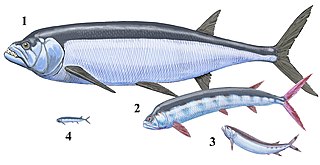
Ichthyodectiformes is an extinct order of marine stem-teleost ray-finned fish. The order is named after the genus Ichthyodectes, established by Edward Drinker Cope in 1870. Ichthyodectiforms are usually considered to be some of the closest relatives of the teleost crown group.

Bothremydidae is an extinct family of side-necked turtles (Pleurodira) known from the Cretaceous and Cenozoic. They are closely related to Podocnemididae, and are amongst the most widely distributed pleurodire groups, with their fossils having been found in Africa, India, the Middle East, Europe, North America and South America. Bothremydids were aquatic turtles with a high morphological diversity, indicative of generalist, molluscivorous, piscivorous and possibly herbivorous grazing diets, with some probably capable of suction feeding. Unlike modern pleurodires, which are exclusively freshwater, bothremydids inhabited freshwater, marine and coastal environments. Their marine habits allowed bothremydids to disperse across oceanic barriers into Europe and North America during the early Late Cretaceous (Cenomanian). The youngest records of the group are indeterminate remains from Saudi Arabia and Oman, dating to the Miocene.
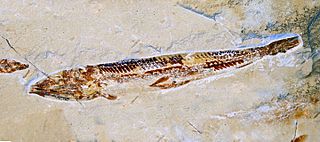
Prionolepis is a genus of prehistoric ray-finned fish belonging to the order Alepisauriformes.
Saurorhamphus is an extinct genus of prehistoric fish. Fossils are known from the Late Cretaceous (Cenomanian) of the former Tethyan region, but an undescribed specimen is also known from Mexico.

Terminonaris is a genus of extinct pholidosaurid crocodyliforms that lived during the Late Cretaceous epoch. The name means: “enlarged snout or nose” at the front of the skull. Terminonaris is an early crocodile, within a subgroup called Mesoeucrocodylia. Its remains have only been found in North America and Europe. Originally known under the generic name Teleorhinus, it was once believed to be a teleosaurid. Both prehistoric crocodiles such as Terminonaris, as well as modern crocodiles, belong to the same group called crocodyliformes, although modern crocodiles have specific features that indicate they are distant relatives of this species and members of the subgroup Eusuchia.
Aipichthyoides is an extinct genus of prehistoric marine bony fish that lived during the lower Cenomanian in what is now the West Bank. Formerly classified in the Polymixiiformes, it is now thought to be a distant relative of oarfish and opahs.
Spathiurus is an extinct genus of prehistoric ray-finned fish that lived during the Cenomanian in the Sannine Formation of Lebanon.
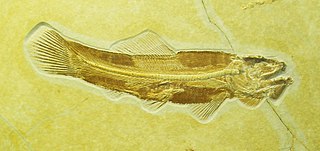
Amiopsis is an extinct genus of prehistoric bony fish belonging to the family Amiidae. Fossils are known from the Late Jurassic Solnhofen Limestone, Germany, the Early Cretaceous Purbeck Group, England, La Pedrera de Rúbies Formation, Spain and Bernnissant Iguanodon locality, Belgium and the Late Cretaceous (Cenomanian) of the Balkans. The monophyly of the genus is questionable, due to it being based on a single character, "the presence of three or more lateral fossae on each side of most abdominal centra". Remains previously assigned to this genus from the Early Cretaceous Las Hoyas, Spain have been moved into the new genus Hispanamia.
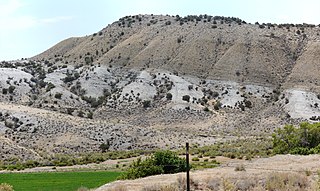
The Mowry Shale is an Early Cretaceous geologic formation. The formation was named for Mowrie Creek, northwest of Buffalo in Johnson County, Wyoming.
Aetodactylus is a genus of targaryendraconian pterosaur. It is known from a lower jaw discovered in Upper Cretaceous rocks of northeastern Texas, United States.
This list of fossil fishes described in 2013 is a list of new taxa of placoderms, fossil cartilaginous fishes and bony fishess of every kind that have been described during the year 2013. The list only includes taxa at the level of genus or species.
The Sierra Madre Formation is a geologic formation in Chiapas state, southern Mexico. It consists of marine dolomites and limestones. The formation dates to the Middle Cretaceous, spanning from the Aptian of the Early to the Cenomanian of the Late Cretaceous.
The El Doctor Formation is a geologic formation in Mexico. It preserves fossils dating back to the Albian and Cenomanian stages of the Cretaceous period.
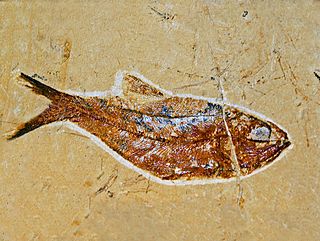
Armigatus is an extinct genus of clupeomorph fishes belonging to the order Ellimmichthyiformes. These fishes lived in the Cretaceous ; their fossil remains have been found in Mexico, Croatia, the Middle East and North Africa, suggesting the genus ranged across the Tethys Sea.
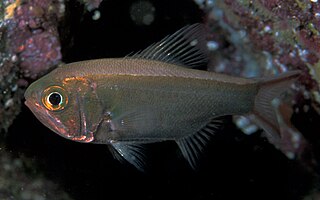
The Trachichthyiformes are an order of ray-finned fishes in the superorder Acanthopterygii.

Enchodontidae is an extinct family of aulopiform fish known from the mid-late Cretaceous. It contains two subfamilies with several genera, including the famous Enchodus, with great morphological disparity among members of the group.

The Enchodontoidei are an extinct superorder of aulopiform fish known from the Early Cretaceous to the Eocene. They were among the dominant predatory marine fish groups in the Late Cretaceous, achieving a worldwide distribution. They were an extremely diverse group, with some developing fusiform body plans whereas others evolved elongated body plans with long beaks, superficially similar to eels and needlefish. They could also grow to very large sizes, as seen with Cimolichthys and Stratodus, the latter of which is the largest aulopiform known. Their most famous member is the widespread, abundant, and long-lasting genus Enchodus.













